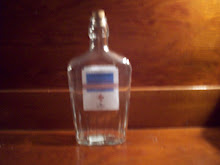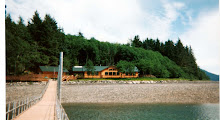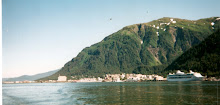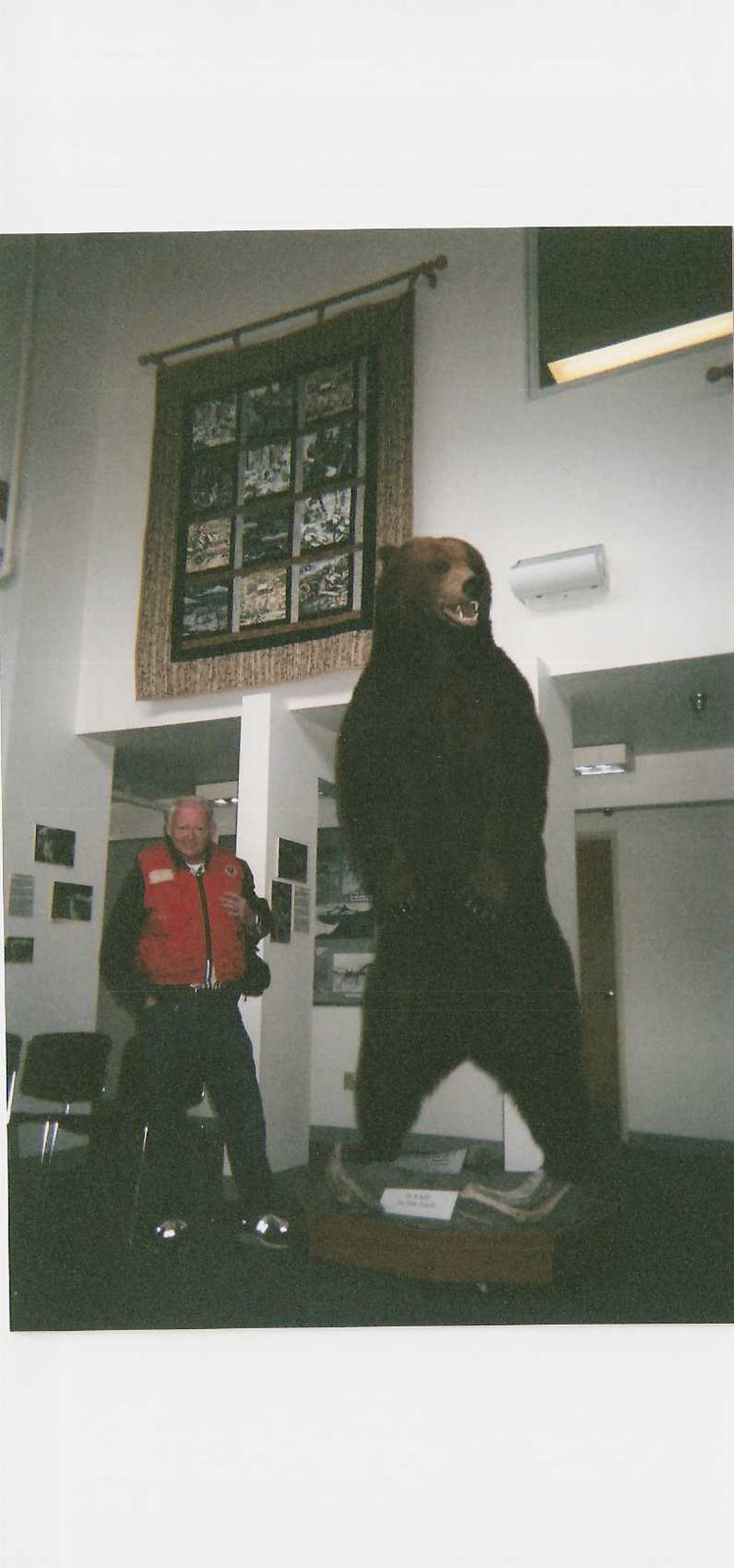by Robert L Gisel
It has been an indelible memory duly impressed upon me the early survival teachings I was initated in when I was a lad. Newly in Alaska, the circumstance that bears were at large was a new element, unknown and definitely a factor to be considered wherever we went.
Our first homestead, a house owned by Ralph Reischel, an old time woodsman, was well off the road at the end of the moderately populated Fritz Cove Road that was by no means city living. Long time Juneau residents lived along this coastal road specifically to be near to the water and far from the city. This put us 13 miles out from downtown Juneau.
We had an access road, one lane of packed dirt that in part went through a stretch of woods. A school bus serviced Fritz Cove Road but we had to walk to the main road down our private access road about 2/10 mile long. It seemed longer then though that is probably all it was, but it was dark.
The shorter days in the winter meant that during the school months it was still pitch black out when we had to go meet the bus. The short patch of woods was even darker and it had shadows and noises. I was only nine and my bother was 11 while my sister was a couple years older yet. Just kids.
We were taught that though the bears probably wouldn't be coming around they could and we had to take measures to avoid them. This was new news, not the usual "don't take candy from strangers" survival coaching kids need in the big city.
This meant talking in the woods was good, or singing, or carry a can with rocks to rattle for noise to announce our presence. If a bear hears you coming he'll most often move out of the way as he really doesn't want the confrontation anymore than you do. Generally.
A sow with cubs can be very protective and really dangerous especially if you get in between the sow and her cubs in which case you could be for it. Given enough advance warning the sow will herd the cubs away and out of danger. Yes, danger, as you are also an unknown to the bears.
A wounded bear is expected to be pretty ornery and quite aggressive. He wants to get even with someone. A bear just doesn't usually stick around though when he hears you coming unless he watches you secretly out of curiosity. The worst scenario is when he sets up an attack plan and is out for blood. This is usually times when he comes out of hibernation and he is mighty hungry or when has been wounded. Sometimes you are just in his feeding grounds and he marks you for punishment.
I asked Ralph what he would. He said if it was an old sow he'd just outrun it. Also running uphill is better as they have shorter hind legs and they really can't run too well up hill. That's comforting to know next time I have a bear chasing me.
Ralph knew a lot about bears. The den in our house still held his collection of exotic bear furs. There was the usual Brown and Grizzly bear pelts hanging there. He also had a Glacier bear which was basically just a Grizzly but with a lighter streak on his back. He had one he called a Blue bear which did have a blue tint when you fanned the back.
His real claim to fame was that he was one of the only trappers around who could successfully trap wolverine alive for the zoos. This was in the 30's and the 40's, long before sedation darts or any technology like that. A wolverine is like a real small bear in some respects. Their fur is thick like a bear, quite bushy, but the wolverine is more the size of a wolf. They are also reported to be even more vicious and every bit as dangerous as a bear especially when cornered or trapped.
Ralph's routine for capturing the wolverine alive was a two man operation. First you have to catch the prey alive in a snare trap. You have to check the traps often, every couple hours. Otherwise the wolverine will get desperate and bite his own foot off to get free of the trap.
When you have caught one alive transporting them was tricky. Their sharp teeth would chew through most anything. For that he devised a metal lined wood barrel.
When he caught one in the snare he went out with a partner and the barrel. The trick is to have your partner distract the fellow while you get around behind the wolverine. Evidently this is much harder than it sounds as getting behind a wolverine especially one you are trying to corner is no small feat. The partner has to get close enough as if to engage in a fight.
Then you work your way around behind the critter and sneak up on him close enough to grab him by the tail and swing him into the barrel. That's all there is to it. Ralph said he had had some whip back around on him though when it all didn't go exactly to plan. He still had his face and all his fingers so it would seem that wolverine wrestling was just part of the fun.
When it came to bears this too was just part of the fun. Ralph coached us how to flee when necessary. Going up a tree for instance can be good, or very bad. You have to pick your tree correctly. Too small and he'll push it over. Too large and he can get his paws around it enough to get a purchase and climb up after you.
Some years later Mom would drive us out to the garbage dump to watch the bears grubbing for something to eat. These were mostly black bears or small browns, used to having people stand around watching them and were pretty harmless. One I walked almost right up to, five feet away with only a fallen over refrigerator between me and him. He never even looked my way, seemingly oblivious I was there.
Sometimes in the wild you just have to pack a gun and know how to use it. In fact whenever you went into any wood where there could be bears it was more than recommended to carry rifle or a heavy caliber pistol. Just a standing rule, have a gun just in case. Personally I never had any encounter with any bears nevertheless.
On a sabbatical one year I was visiting my folks in their retirement cabin at Colt Island and wanted to go wander around exploring nearby Horse Island. You can walk to it at low tide on the spit that connects the two islands. My step dad gave me a rifle to carry as there was a resident bear on Horse. The bear usually hung out behind old John's house hoping John would throw something out he could eat.
I walked around the island several times watching for the bear but mostly was entertained by the deer, doe and fawn tracks that went around the island as they kept on the opposite end from me. I got bored with that and was going through the woods and noticed a patch of skunk cabbage the deer had been eating. The stems had been freshly broken off and hadn't had time to start juicing yet so it was very fresh sign.
At the north end I encountered a fellow who was roasting a weener over the most pitiful tiny fire built of small twigs like he was afraid of it. He wanted to know why I was carrying a rifle and I told him about the bear that lived on Horse. He blanched. Apparently he was kayaking around southeast Alaska, by himself, and he had slept on the island having the idea no bears could be there. He was really a cheechako (Alaskan for greenhorn).
When I got back to Colt my folks wanted to know if I had seen the bear. I hadn't but told them about the deer sign including the very fresh sign in the skunk cabbage patch. That's when I was informed deer don't eat skunk cabbage. Bear eat skunk cabbage. I guess I have been spending too much time in LA. Heaven forbid someone mistake me for a Cheechako.
My Mom had remarried to Lynn Forrest Jr, Bud, a retired architect, and he has had some brushes with bears and dropped a few in self defense. This is where I learned about the bear in an attack plan. The bear is kind of dumb in that he will sometimes formulate a plan to come around and jump you but if the plan is foiled he'll try to go through with it anyway.
On a fishing trip Bud and three buddies were coming back down the trail with their catch. Bud was up front with one friend and the other two were about a hundred yards back. He spotted a bear moving along the other side of the stream who had not seen him yet. Bud had his friend stop and be quiet. The bear's plan was evident, he was going to cross the stream and double back and jump the other two fishermen.
The bear started across the stream towards Bud and that's when he saw them. He kept going on the plan of attack but this time towards Bud and his friend and he broke into a charge. Ready for him with his rifle Bud got a shot into his shoulder joint aned dropped him. Unfortunately they had their fishing licenses but no bear ticket so they had to leave it there for Fish and Game as otherwise they would just get arrested and fined.
I think the ultimate though is my brother's story about going out as the backup gun for his friend who like to bow hunt and wanted go after some bear. That's really looking for trouble. But that's a tale for another blog post, if you're interested.
http://www.robertgisel.com/












